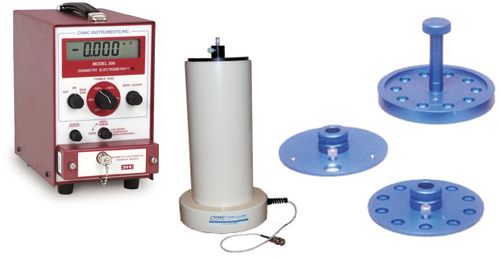
Brachytherapy QA
Please click the product you want to learn more about:
i. Well Chambers
Model 44G Well Chamber for LDR, HDR and IVR
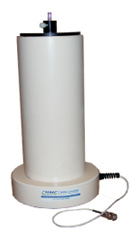
The 44G is a hermetically-sealed re-entrant well ion chamber, requiring no air density corrections. The fill gas is pure argon at an absolute pressure of 23.5 psi, which provides three distinct benefits. First, through photoelectric absorption, argon enhances the response at low energies emitted from 125I and 103Pd. Second, because of its low electron attachment coefficient, argon provides a higher ion collection efficiency, making it more suitable for 10 Ci HDR 192Ir sources. Third, the positive pressure provides long term constancy measurements with the ability to verify the chamber seal.
The 44G is fully guarded into the chamber and is equipped with a 1.5 meter triaxial cable. It may be connected to any precision, dosimetry-grade electrometer. To cover the entire range of clinical sources from 125I (Iodine-125) seeds to HDR 192Ir (Iridium-192), the electrometer should be capable of resolving at least 10 fA and measure up to 2000 nA or 20,000 nC.
Model HDR1000+
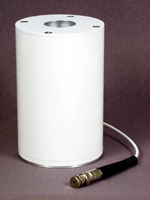
Brachytherapy Re-Entrant Well Chamber
The rapid increase in oncology centers providing high dose rate brachytherapy treatments has prompted an intense interest in calibration procedures for high dose rate Iridium-192 sources. Calibration of sources is necessary because some sources are delivered with ±10% specifications. One facility’s experience has shown a variation of 15% in sources.
Calibration with Farmer-type ion chambers requires a very time-consuming procedure of 1 to 2 hours. For proper calibration, the jig and Farmer method requires multiple distance measurements which must be accurate to less than 1mm. Scatter is produced by the jig apparatus which must be accounted for.
The HDR1000+ ion chamber, initially conceived by Professor Herb Attix, is designed specifically for use with high dose rate Iridium-192 sources. A typical calibration time using the HDR1000+ ion chamber is 15 minutes. It eliminates any need for multiple distance measurements, therefore eliminating any chance of imprecision due to distance errors. All scatter is accounted for as part of its calibration factor. The HDR1000+ now offers a simple, reliable means to calibrate Iridium-192 sources and to verify decay rates.
The HDR1000+ is supplied with one HDR source holder and a storage case.
Source Holders for HDR1000+
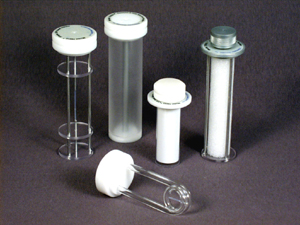
70003 - Remote Afterloading
This source holder is for cesium remote afterloading and has a 7.1mm diameter aluminum catheter opening. It is used with LDR remote afterloading systems. There is no spacer because the afterloader positions the sources. This insert can also be used with cobalt sources used in some LDR remote afterloading treatment systems.
70009 - Iridium-192 Ribbons
This source holder for LDR Iridium-192 ribbon seeds has a 3mm diameter acrylic tube which extends from the top of the insert to the most active area of the chamber. It makes one loop at the active area and extends back to the top of the insert. A collective calibration of the entire ribbon of seeds is obtained. Fourteen seeds spaced one centimeter center-to-center can fit into the active area.
70010 - Iridium-192 HDR
This source holder for HDR Iridium-192 has a 2.2mm opening for the catheter. A rubber O-ring secures the catheter with a uniform restriction pressure to prevent any movement of the catheter. The ADCL calibration report provided with the HDR1000+ well chamber indicates the most sensitive position within the chamber, so that the source can be exactly repositioned for all measurements.
70016 - Individual Seed
This source holder for individual isotope seeds has a 1mm inner diameter Teflon catheter which positions the seed in the active area of the HDR1000+ well chamber. The tubing is smooth Teflon for easy removal of the seed. Iodine-125, Palladium-103, Iridium-192, and Gold-198 seeds can be placed in the source holder.
70020 - Cesium-137 Tube Sources
Source holder for cesium has a 5mm diameter aluminum catheter opening and is commonly used with manually loaded cesium sources. A spacer within the source holder positions the cesium insert at the most active area of the well chamber. The spacer for positioning the cesium source is removable so that the insert can also be used with some longer cesium sources, and with larger HDR catheters.
70022 - Seed Batch Assay
Designed for LDR seed batch assay, this source holder holds up to 500 of the iodine or palladium seeds typically used for prostate cancer treatment. The entire batch of seeds can be measured (assayed) at one time. This method is described in "Verification of Manufacturer Supplied Iodine-125 and Palladium-103 Air-kerma Strengths", Mellenberg and Kline; Medical Physics 22(9): pp.1495-1497, 1995.
70022 - Iridium-192 Wire Coil
This source holder is designed so that the measurement of activity of iridium wire coils can be performed accurately. The coil is placed in the tube and uniformly compressed to 2mm for measurement at the most sensitive point of the well chamber. This consistent positioning provides for excellent reproducibility of measurements.
70023 - Iodine-125 RAPID Strand
This source holder provides a quick and convenient QA measurement of RAPID Strand iodine seeds. Rotational dependence and short term precision is less than 1%. The measurement is made on one half of the RAPID Strand at a time while the RAPID Strand remains in the jig. The spacing jig is then inverted and the five seeds at the opposite end are measured.
Accessories for HDR1000+
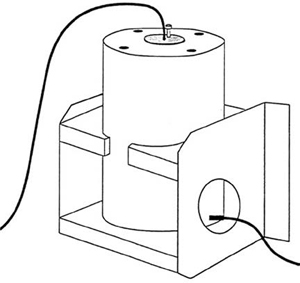
Model 70008 - Quality Assurance Insert
The Quality Assurance Tool tightly collimates the radiation received by the HDR1000+ ion chamber to a narrow plane. Four short measurements are taken as the Iridium-192 source is advanced to the 4mm opening. These measurements provide the information for:
- Source positioning verification
- Timer accuracy
- Consistency of source activity
A constant, K, is determined with formulas outlined in the instructions. If all of the determinants of K remain within 1%, the user can be assured that the source position has remained constant to within 0.3mm, the source activity calibration has remained constant to within 0.01Ci, and the error in dwell time is less than 0.1 second.
Model 70007 - Wall Mounted Bracket
Periodic Quality Assurance for your High Dose Rate Remote Loading System.
Verification of Source Presence:
Check the relative output/activity of your source each day before patients are treated, and again at the end of the day.
Source Strength and Calibration Accuracy:
The rate of readings to calibration should be constant after decay of (73.83d = T(½)) regardless of wall scatter. This provides a verification of your source strength, thereby assuring the accuracy of your calibration.
Timer Consistency:
Two or more readings with the same setting will indicate the consistency of the timing operation.
ii. Electrometers
Model 206
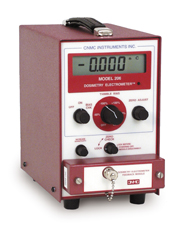
Brachytherapy Electrometer
The CNMC Model 206 Electrometer, with its innovative modular design, can be set up with an appropriate input feedback module to accurately measure a wide range of current output from any well chamber. LDR sources as low as 0.1mCi of Iodine-125 can be measured with a 4-digit accuracy. 10Ci Iridium-192 HDR sources can be measured in charge or current mode.
One removable feedback module optimized for LDR or HDR is supplied with Model 206. Additional input modules may be purchased to suit other applications. The 200nC module can be added to economically extend electrometer use to calibration of teletherapy machines. The extra input modules can be stored conveniently in the compartment located in the rear panel of the Model 206 when not in use.
Because most well chambers exhibit high capacitance, use of an external 300V bias battery is recommended to assure stability of LDR measurements. This battery can be stored in the rear panel compartment of the Model 206.
Model MAX-4000
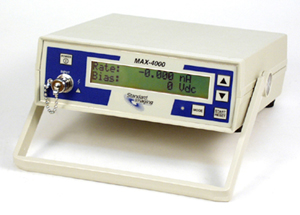
Brachytherapy Electrometer
Exceptional sensitivity and a wide dynamic range makes the MAX-4000 electrometer a good choice for brachytherapy measurements. In rate mode it provides immediate measurement of even the lowest activity isotopes. For example, a 0.27mCi iodine seed, measured in the HDR1000+ well chamber, gives a signal of 1.458pA. The MAX-4000 can measure 10Ci and higher iridium sources in rate mode or integrate mode over time.
The built-in countdown timer can be preset in 15 second increments up to 600 seconds. A few buttons control all operations. Zeroing is automatic; press a button and you are ready to measure. A digital filter built into the MAX-4000 eliminates the effect of noise resulting in a very stable and exact measurement.
The MAX-4000 is versatile enough to be used for all external beam applications, using Farmer-type ion chambers, chambers typically used for data acquisition in water phantoms and chambers used for quality assurance tests.
The MAX-4000 is designed to exceed AAPM, ADCL and reference-grade instrument stated specifications in many areas, including reproducibility, resolution, linearity, long-term stability and repeatable measurement accuracy.
iii. Brachytherapy Accessories QA
Seed Handling Accessories
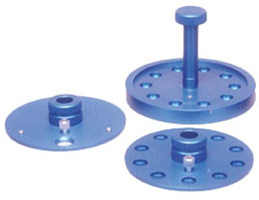
90-085, Seed Sterilization & Sorting Tray
Sterilization of LDR brachytherapy seeds is necessary before being placed into the patient. The LDR seed sterilization and sorting tray is designed to allow you to sort seeds into ten separate hemispherical wells 16mm diameter and 10mm deep. The well numbers are stamped into the aluminum for identification. Seeds of different strengths may be placed in different wells for storage. Each well can easily hold over 100 seeds. The tray is 160mm in diameter, so it will easily fit into all autoclaves.
During sterilization, the 5mm thick aluminum cover is positioned 10mm above the seeds. The drying cycle dries the seeds before the tray is removed from the autoclave. Dry seeds are easier to load than wet seeds. Other storage devices may leave the seeds wet and difficult to handle.
Before and after sterilization, the aluminum cover is locked down over the wells to shield the personnel from radiation. The rotation cover has one opening that can be positioned over only one well at a time. During use, seeds from only that well are exposed for loading into your treatment system, while the unused wells are covered to prevent additional exposure to radiation. The cover can be positioned between two wells for complete shielding and locked to prevent spilling the seeds while transporting.
90-090, "Seed Slider"
The Seed Slider is specifically designed to be the most efficient instrument for loading seeds and spacers into prostate implant needles. The Seed Slider interfaces with the Model 90-085 Seed Sterilization and Sorting Tray to provides a compact, safe and efficient needle loading platform. It consists of a specially designed reservoir and sorting area. The reservoir allows access to all seeds stored in the wells inside the Seed Sterilization and Sorting Tray, so users can scoop seeds from the wells onto the loading platform with the provided spatula. The seeds and spacers are then aligned into a slot per the treatment prescription. A cover then flips up to encapsulate the seeds and spacers. The needles lock onto one side of the Seed Slider with a Luer™ lock. The needle stylet is inserted and the seeds and spacers are smoothly pushed into the needle. The Seed Slider and Seed Sterilization and Sorting Tray are sterilized together, saving time and effort.
90-095, Needle Cradle
Designed for storage of loaded LDR prostate implant needles, the Needle Cradle features eleven horizontal rows, as nine rows are sometimes inadequate for large prostate volumes. Aluminum templates are easily interchangeable for any ultrasound or treatment planning system, starting a 1.0 or 2.0. Only one box is needed for any current or future treatment plan. Shielding exceeds the NRC requirements of less than 1mR/h at a distance of one meter (with 0.35mR/h seeds). A lightweight, stainless steel needle guard slips over needles to prevent accidental bumping of stylets. The guard can be removed and stored if not used. The bottom plate prevents loss of any seeds that may become loose.
Model 9404
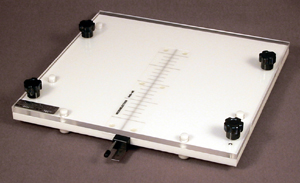
Perma-Doc Phantom
The Model 9404 Perma-Doc Phantom provides the necessary permanent documentation required by the NRC’s new and stringent quality assurance tests associated with HDR. The Perma-Doc, with its centimeter scale automatically transferred to the film by fluorescent radiation, readily identifies up to 20 source positions and their stepping accuracy.
Two matching 0.375" acrylic plates allow for insertion of a 10" x 12" ready-pack film. The film is exposed by the HDR Iridium-192 source with dwell times of 1 second over a maximum of 20 positions spaced 1cm apart. The resulting film displays the source images superimposed on the image of the centimeter scale.
Models 640-M & 640-R
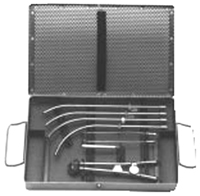
Afterloading Applicators
640-M Delclos Mini-Ovoid – The Delclos Mini-ovoid afterloading applicator is designed for the treatment of cervical cancer in patients with narrow vaults.
The sterilization tray holds the applicator and components securely in place during transportation or sterilization. Covered with special plastic, the applicator and components do not come in contact with the tray’s metal. The screen type cover and bottom allows free entry of steam or gas.
640-R Fletcher-Suit Delclos – The Fletcher-Suit Delclos afterloading cervix applicator is probably the most commonly used applicator for the treatment of cervical cancer.
The FSD Sterilization-Storage Tray holds the applicator and components securely in place during transportation or sterilization. Covered with special plastic, the applicator and components do not come in contact with the tray’s metal. The screen type cover and bottom allows free entry of steam or gas.
Model 670 Delclos Uterine/Vaginal
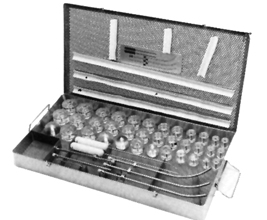
Afterloading Applicator & Dome Set Assembly
The Delclos uterine/vaginal afterloading applicator is primarily used for the irradiation of tumors extending downwards along the vaginal vault from the cervix. The dome assembly is used in patients where a hysterectomy was performed. The dome assemblies can be linked to the different diameters of the vaginal cylinders, providing good surface contact throughout the vagina for uniform dose distribution.
Model 8134 Rectal Marker – This device is used with localization fields in intracavitary applications. With the old method of using a soldering or other type of wire, only the position of the rectum could be obtained. With the rectal marker, it is now possible to obtain both the rectum position and magnification, which allows accurate determination of the rectal distance from the radiation source.
It consists of a 6mm diameter tube, 32cm long, with a handle at one end. The entire length of tubing is packed with radiopaque markers accurately spaced 1cm apart, center to center.
Model 8114, Anderson Cervix Marker Kit consists of an implant needle, 25cm long and 50 markers of 0.8mm diameter, 5mm long. The metallic markers are easily visible on visualization films and also aid in treatment planning. The implanter has a flange attached, allowing implantation of one marker at 1cm depth.
Shielded Workstation
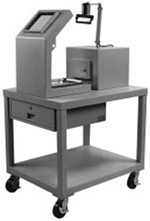
Afterloading Applicator & Dome Set Assembly
This sturdy workstation is the ideal vehicle for the safe storage of radioisotopes. Optimum protection is provided to personnel from radiation exposure when storing isotopes. The workstation has sufficient work and storage area to allow flexibility when using its contents. Heavy duty 5" casters lend mobility to the work station and permit transportation of radioisotopes to the point of use under hazard-free conditions. The following components may be purchased separately:
L-Block Lead Shield, Model 990-488
Features a wide view, 4" thick, tilted leaded glass window that provides easy viewing of the radiation source loading area and offers maximum eye and face protection. The L-Block is made of sheet steel with 5cm of lead shielding inside to protect the head and torso from radiation. Two holes are provided for lifting the unit.
Stainless Steel Tray, Model 990-900
For use with the L-Block Shield. Provides an easy cleaning area.
Halogen Spot Lamp, Model 990-050
This high intensity, bright beam of light gives good visibility of radiation sources and holders. A 20 watt, 12 volt spot lamp is mounted to a five-axis adjustable arm. Operates on 120 Volts AC. Optional 2 to 1 magnifier Model 999-052 attaches to the lamp and optional stud. Model 999-053 is used to mount the lamp to the top of radiation safe.
Shielded Storage Safes
Constructed of steel and shielded with lead, these safes provide maximum protection from radiation exposure. The door swings open 180° so it is out of the way and is reversible to open in the opposite direction. It is key locked and fireproof. The key is needed to open the door and then can be removed. An eyebolt is furnished on top of the safe for lifting, which can be removed to be replaced with a lamp holder stud for lamp mounting. The finish is durable light tan textured polyurethane enamel. Stainless steel source storage drawers are equipped with a pull handle and have storage space 6" long, 1.5" wide and 1.5" deep. Drawers can be fitted with optional lead inserts.
Steel Table, Model 992-020
This smooth, round-edged table provides a solid support surface for the radiation work station. The table support frame is tubular steel with welded joints for maximum strength. The table is mounted on four 5" diameter locking swivel casters. Included is a locking storage drawer and a heavy duty lower shelf for storing radiation pegs and supplies.
Lead Inserts
Model 998-014 is a 14-hole lead insert with caps for unused holes. Insert is permanently marked with mg of activity per customer’s specification. Hole size: 3.1 or 2.65mm dia. x 20mm long, specify diameter and source activity in mg when ordering.
